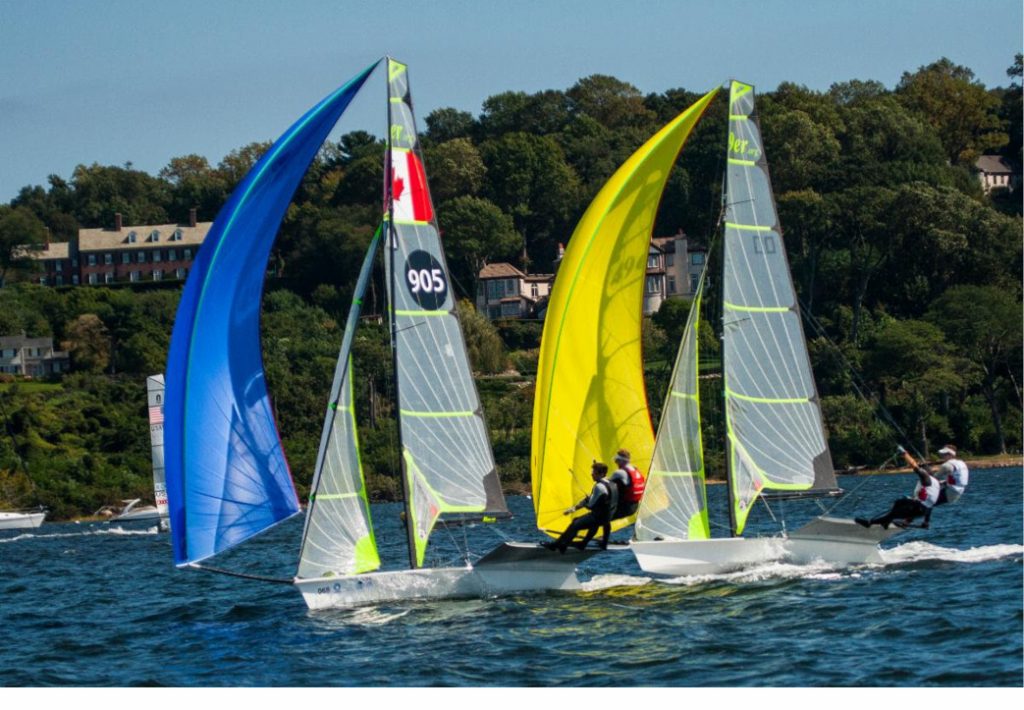A layline is the path you would sail, when steering your optimal upwind or downwind course, to get around the next mark on one tack. We all know that laylines are invisible, of course, but many sailors don’t realize how much (and how often) laylines move around.
Laylines are a function of many variables such as wind direction, wind speed, sea state and current strength. Therefore, whenever there is a change in any one of these things (and they do change every moment), your layline will move. In order to make good layline choices, it’s important to keep your head out of the boat and to understand how all these variables may influence your layline calls.
Boat type – Laylines are, first and foremost, a function of your boat’s tacking and jibing angles. When you are sailing a narrow-winded Etchells, for example, you will obviously get to the layline sooner than you will in an Optimist, which tacks through about 90 degrees.
If you haven’t done so, make up a chart for your boat that lists wind velocity and your corresponding upwind and downwind angles. Combine this with tacking lines to help make layline calls in any wind condition.
Wind direction – The wind direction is almost always changing, at least a little, and this has a direct impact on the location of all your laylines. For example, if the wind direction shifts 5 degrees to the right, then the laylines will also move by 5 degrees. On a shifty day, you must be tuned in to the windshift pattern in order to make good layline calls.

The best way to call a layline is to avoid getting near the layline until you are relatively close to the mark. If you try to make the call from far away, you risk overstanding by a lot or ending up in bad air. © oakcliffsailing.org
Leeway – One small influence on laylines is leeway (i.e. the angle between the course you’re steering and your course made good through the water). Every boat makes at least a little leeway because of the sideways push by wind and waves. This will be greatest (maybe 3 or 4 degrees) in strong wind and big waves.
Wind pressure – Wind pressure affects your boat’s tacking angle and usually has an even greater effect on your jibing angle, so it will have a corresponding impact on laylines. In light air your laylines will be wider apart because you can’t point so high (or so low downwind). As the breeze builds, laylines get narrower, especially to the leeward mark. Before calling any layline, look at how much pressure you will get on your way to the mark and make your call accordingly.
Current strength and direction – When the water is moving, this can affect laylines more than almost any other factor. Expect the greatest impact when:
• the wind is light and the current is strong; or
• the current is running at an angle that is nearly perpendicular to your layline. Note that the direction of the current may affect your layline(s) on one tack much more than on the other.
Sea state – The presence (or absence) of waves (caused by wind, motorboats or anything else) can have a significant impact on your laylines. The more chop you have, the more you will have to go for footing instead of pointing, which means your tacking (and jibing) angle, and thus your laylines, will be wider. One exception is when you have enough wind and waves to surf downwind – this will make your jibing angle surprisingly narrow and your downwind laylines correspondingly deeper. ■
This article originally appeared in David Dellenbaugh’s Speed & Smarts, The newsletter of how-to tips for racing sailors. If you want to sail faster and smarter, log onto SpeedandSmarts.com.



